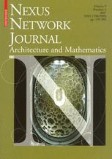Search
Search Results
-
Gothic Vaulting in Spanish Military Architecture from the Eighteenth Century
The construction of gunpowder magazines, undertaken by military engineers in Spain throughout the eighteenth century bears testament to the...

-
History, Geometry and Stereotomy in the Vaults of the Halle au Blé
This paper analyses the history, cultural background, geometric configuration and stereotomic apparatus of one of the most interesting buildings in...

-
Architectural Inversions: The Intangible Aspect as a Form-Finding Factor in the Combined Work of Antoni Gaudí and John Pickering
This paper discusses the working methodology in the design process of architect Antoni Gaudí and artist John Pickering and identifies common...
-
From Scripting to Structural Computation of Conical Vaults
This paper discusses the use of scripting procedures and structural computation applied to the stonecutting of vaults. Starting from the...

-
Mathematics, History of Mathematics and Poncelet: The Context of the Ecole Polytechnique
Jean-Victor Poncelet (1788–1867) is known as a geometer whose mathematical contributions were crucial for the development of what would later become...
-
Interpreting Lecce Vaults with Analytical-Geometrical Models
The paper introduces a generalised geometrical model capable to reproduce, with the assignment of four parameters, all the different types of the...

-
The development of geometry in the 17 th and 18 th centuries
From about 1630 until approximately 1800 (when mathematics yet again took a profound turn due to reasons we will discuss later on), those scholars...
-
Prodromes of Descriptive Geometry in the Traité de stéréotomie by Amédée François Frézier
Among the sciences involved in the theorization of descriptive geometry, the stereotomy played a prominent role. The knowledge of the theory of the...
-
From Mediaeval Stonecutting to Projective Geometry
We tend to think about technology as the application of abstract science to practical problems, but sometimes the inverse is true, as in the case of...
-
Descriptive Geometry: From its Past to its Future
Descriptive geometry is the science that Gaspard Monge systematized in 1794 and that was widely developed in Europe, up until the first decades of...
-
La Gournerie versus Monge
Jules de la Gournerie was one of Gaspard Monge’s successors in the teaching of Descriptive geometry and its applications, and both dealt with similar...
-
Developable Surfaces: Their History and Application
Developable surfaces form a very small subset of all possible surfaces and were for centuries studied only in passing, but the discovery of...
-
Oval Domes: History, Geometry and Mechanics
An oval dome may be defined as a dome whose plan or profile (or both) has an oval form. The word “oval” comes from the Latin ovum , egg. The present...
-
Oval Domes: History, Geometry and Mechanics
An oval dome may be defined as a dome whose plan or profile (or both) has an oval form. The word “oval” comes from the Latin ovum, egg. The present...
